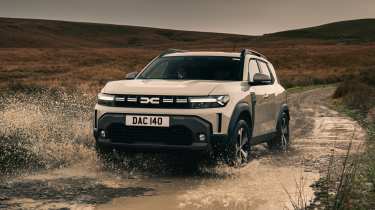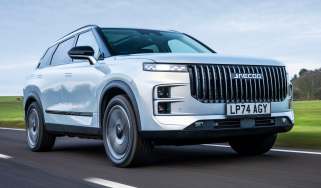Dacia Duster review - Engines, drive & performance
“The Dacia Duster’s engines perform well, and there’s even some off-roading capability on offer”
The latest Dacia Duster has a more grown-up feeling than before, and that’s true of the driving experience, too. While it weighs almost the same as the outgoing model, it feels pleasantly heftier from behind the wheel.
The driving position is good and so is visibility, although if we were to criticise anything about it, the shallow rear window could be a little larger.
Dacia is marketing the latest model as even more off-road-capable than before, and it can be had with a choice of two-wheel drive or four-wheel drive if you go for the new 1.2-litre engine. We tried both versions, but were impressed with how capable the Duster felt off-road, traversing large obstacles with ease, despite the car sitting on regular all-season tyres. You get a selection of drive modes comprising Auto, Snow, Mud/Sand, Off-Road and Eco.
Although more and more manufacturers are ditching manual transmissions, the latest Dacia can still be had with a six-speed manual, unless you go for the Hybrid model, which is a four-speed automatic only.
No version of the Duster will get your pulse racing – the onus here is on comfort and smooth power delivery across the board, and in this respect the Duster does well. While we had to work the six-speed more than expected, it was at least a pleasure to use.
More reviews
The Duster’s squishy seats make for a comfortable ride, although the suspension itself isn’t the best at smoothly ironing out larger bumps or holes in the road, and can occasionally feel somewhat unsettled as a result.
While the previous Duster was offered with a diesel option, this is not the case for the current model.
Is the Dacia Duster good to drive in town?
We’re pleased to report that despite the Dacia Duster’s sense of adventure off-road, it’s still well suited to urban environments. It offers light steering and a surprisingly tight turning circle that makes it well suited to around-town driving. This, plus its good visibility means buyers should find it a doddle to drive in the city, where they are likely to spend the vast majority of their time.
Dacia claims the Hybrid can be in engine-off mode for up to 80% of the time around town, and it does feel possible in reality. We found the petrol engine would kick in once the car hit 25mph, but even once driving along the combustion engine would often switch off, and the juggling of power was quite smooth. The ‘B’ mode for extra regenerative braking is also helpful in city driving, as you can use it to slow the car down without having to press the brake pedal so often.
Is the Dacia Duster good to drive on long journeys?
The Dacia Duster should be a good performer on long journeys, thanks firstly to its comfortable driving position. Overall refinement is good, although we were less impressed with wind noise at higher speeds, which was a little more intrusive than it ought to be.
Is the Dacia Duster good to drive on B-roads?
B-road blasts aren’t really what the Dacia Duster is designed for, but it’s predictable in terms of driving feel and has accurate steering, so it inspires a fair amount of confidence if you do give it some through the corners. There’s a noticeable amount of body roll, but despite this, the Duster does hold on gamely.
Petrol models
The Dacia Duster now comes offered with a new mild-hybrid-assisted 1.2-litre turbocharged petrol engine, and this version gets the option of four-wheel drive. The entry-level 1.0-litre Bi-Fuel model offered in Europe won't make it to the UK.
When we tested the 1.2-litre model, we found it suited the Duster well, with just enough power that it didn’t feel lacking. We think it will be well-suited to most drivers, especially since the Hybrid model only boasts an extra 10bhp and is actually slower to get from 0-62mph.
The entry-level TCe 100 Bi-Fuel is the slowest option, but its performance also varies slightly depending on the fuel it's consuming. While running on petrol it's actually a bit slower, taking 14.1 seconds to hit 62mph from rest, while switching to LPG reduces this to 13.2 seconds.
Hybrid model
While the Duster Hybrid’s power figure is quite a way down on the 193bhp in the MG ZS Hybrid+, the fact the Duster always pulls away with assistance from its electric motor helps it to feel quite sprightly. It’s at its worst when asked for heavy acceleration, such as when joining a motorway, because revs tend to flare, resulting in quite a drone from the engine. At least it does settle once up to speed.
If you want an automatic gearbox the Hybrid is the only one with this type of transmission from launch – it’s not the best system, though, because when we tested it, it regularly struggled to choose the correct gear. Once it did settle on one, though, gear changes were generally smooth.
| Model | Power | 0-62mph | Top speed |
| 1.0-litre turbocharged TCe 100 Bi-Fuel | 99bhp | 14.1 seconds | 101mph |
| 1.2-litre mild-hybrid turbocharged TCe 130 | 128bhp | 9.9 seconds | 112mph |
| 1.2-litre mild-hybrid turbocharged TCe 130 4x4 | 128bhp | 11 seconds | 112mph |
| 1.6-litre Hybrid 140 | 138bhp | 10.1 seconds | 99mph |
Carbuyer notes
“The Duster really stands apart from more expensive rivals thanks to its off-road ability. We tried the 4x4 model and were amazed at the obstacles it could conquer – even on normal all-season tyres.” Alastair Crooks, Senior News Reporter
















